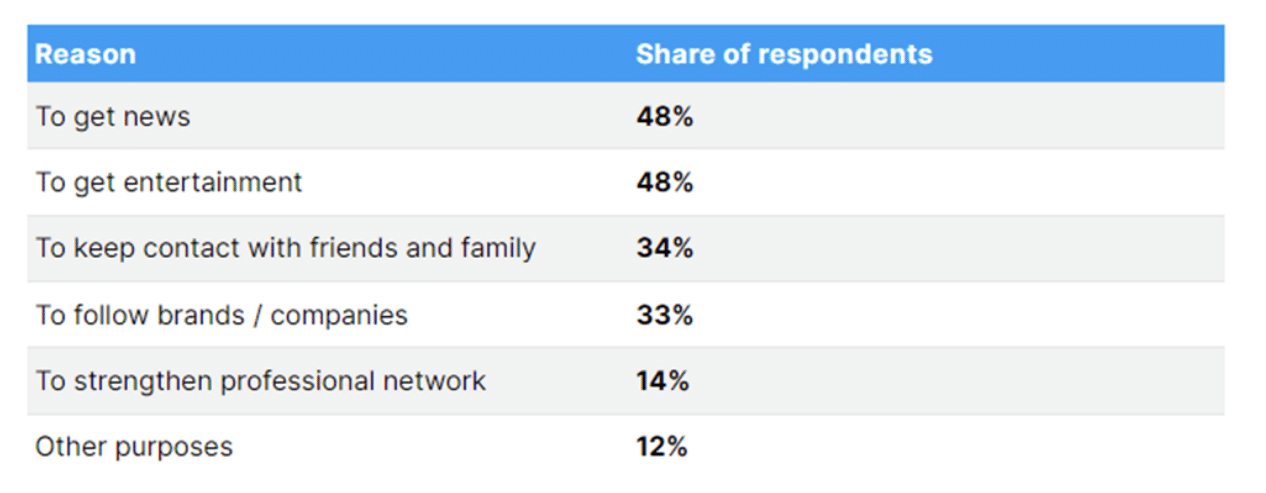Journalists play an important role in shaping public opinion. There are few professions only that can equal or surpass the impact journalists have on the socio-economic and political landscape. An association with journalists can do wonders for your brand image. Not every brand, however, can afford to have a very close association with journalists, especially mid-level and small businesses. The most feasible substitute for it, therefore, is to engage with them on a social media platform, like Twitter. You may now be wondering, why Twitter? Here’s the answer:
Twitter is a formidable social media platform used by about 4.48 billion people worldwide. Since most people use Twitter to get news, engaging with journalists on this social media platform has a significant value proposition for marketing and PR.
Source: Statista
To engage with journalists, however, a soft approach might result in messages being lost, while a straightforward approach is frequently misinterpreted as spam. There are, however, several efficient techniques to reach out to journalists using Twitter. Here are 11 of the top tips:
1. Complete your own Twitter profile first
Anyone would prefer not to connect with someone they don’t know about. In the case of journalists, who are already overwhelmed with connection requests, it’s impossible!
To look genuine and solemn about the presence of your business on Twitter is indispensable if you want to connect with journalists. Therefore, showcase yourself and your business honestly, and take the first step towards engaging with journalists on Twitter.
2. Create a list of journalists on Twitter
Just like businesses create or procure email lists or users’ lists to pitch their products and services to the relevant audience, you must also do the same thing for journalists. Create an authentic and informative list of journalists so that you can segment them and send personalized communication based on their persona.
3. Establish yourself as a thought leader
Go-to people are respected in every nook and corner of the world. A thought leader is an opinion leader in their field, and what they say is taken seriously.
And, if you are not taken seriously in your own field, why would someone from another field take you seriously? And that too, a journalist?
In the following video, Robert Scoble provides 4 easy tips to become a thought leader:
Source: YouTube
4. Pitch them stories that are essentially data-driven
A lie travels much faster than the truth. In the information age, ironically, we get less information and more fake news. And who’d know this better than a journalist?
To look more reliable and credible, therefore, whenever you’re pitching any story, make sure your premise is data-driven, i.e. backed by enough data.
5. Read, like, and share content
Those who have stopped reading, a substantial part in them has already stopped living. How would someone, therefore, engage with another who’s already dead!
On a serious note, when you read quality content, you write quality content, and you like quality content, and also you share quality content. With so much quality, you attract quality people, like the journalists, and look not only interesting, but also educated.
6. Show your commitment by following them first
No matter how educated, active or responsible you may be, it’s you who wants to have an association with them. So, make sure to follow them before sending any direct message. This is the best way to make them understand that you are really interested and committed to engaging with them.
7. Stand out by leaving thoughtful comments
There’s this saying: “If you want to be great, do something that’s worth writing, or write something that’s worth reading.” Drawing parallels with our article, it’s the second part I’m talking about.
The quality of your writing must be evident in your comments with the added flavor of thoughtfulness. Outstanding comments on the posts of your targeted journalists make a good impression of being responsible, knowledgeable, and interested.
8. Say thank you by tagging and sharing
In anything you achieve where they’ve been a motivating factor or responsible in any other way to even a very small degree, it’s quite good to tag them and share your content. There’s no other better way to say ‘Thank You’.
Also, by sharing and tagging the relevant journalists, you’re directing your followers to them and boosting traffic to their website. Journalists may even consider coming back to you for content if they find you capable.
9. Avoid engaging with them on Facebook and Instagram
If your aim is to be limited to a fan or an enthusiast, you wouldn’t leave any platform to follow them. Nothing wrong with that!
If, however, your aim is to engage with them on Twitter, I reckon it should only be the platform you should follow them on. It will help in keeping your relationship highly professional. Entering someone’s personal space without being invited is not a reasonable thing to do, especially if your plans of engaging with them are limited only for business.
10. Join online communities and events related to journalists
To learn more about journalists, how they work, and what they’re interested in, there’s nothing wrong in attending a journalist-focused event or joining an online community of journalists. It’s the best way to keep yourself updated, and in touch with them.
Do not, however, try to sell your latest product or service to them without any context. It’ll simply annoy them and make you look insensitive, and the worst part, cause far more harm than any good.
11. Do not stalk them in the name of following
You shouldn’t, and honestly speaking, can’t like everything a person (especially if they’re quite active on Twitter) is doing on social media, unless you’re a die-hard fan. And performing like, comment, and share everything left, right, and center like a ritual will spoil your game of engaging.
The best approach, therefore, is to show moderation in interacting with them. Do not like and comment on everything, especially where you might seem like a stalker or a sycophant.
The bottom line
Organizations don’t leave any stone unturned when it comes to consolidating their brand image. That’s the reason why a significant amount of time and effort is invested in public relations. The power and impact of PR is amplified by introducing social media into the mix. Platforms like Twitter allow the outreach of content in several forms to be faster and catering to a wider audience. Our discourse in this article had been centered on 11 useful tips on how to make it easier to engage with journalists on Twitter so that your PR and marketing boosts considerably.
You can utilize these tips and even add a few approaches of your own to make a list to follow, and then have a good association with several journalists on Twitter.










